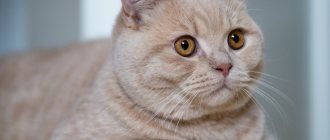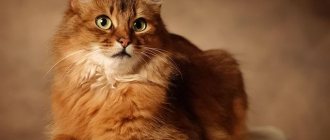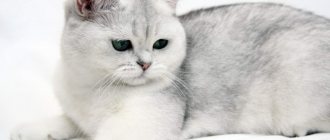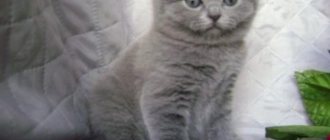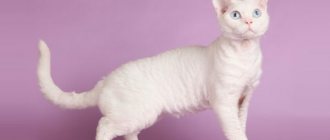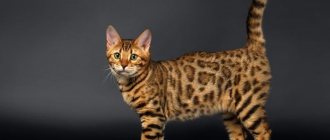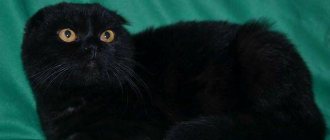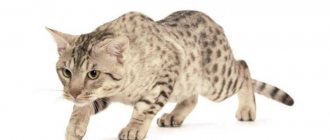- Pets
- >>
- Cat breeds
* Here is a photo of a typical representative of the British Shorthair cat breed . You can send us photos of your animals by email, and we will post them on the website. Don't forget to send your pet's name.
Video
* We invite you to watch a video about the British Shorthair cat . In fact, in front of you is a playlist in which you can select and watch any of 20 videos about a given cat breed by simply clicking on the button in the upper right corner of the window. In addition, the material contains quite a lot of photos. By looking at them you can find out what a British Shorthair cat looks like.
In this article:
|
Breed characteristics
The characteristics of the breed must correspond to the standard description.
The British cat is a creature with a large head, a strong build, and excellent plush short hair. The British man’s facial expression is good-natured and benevolent, reminiscent of the well-known “Cheshire Cat”.
Characteristics and features of the British Shorthair cat breed:
- Round, large and wide head, with a powerful chin;
- The nose is wide, short, slightly curved, there is no “stop”;
- Full cheeks, have large whisker pads;
- The ears are small, rounded at the ends;
- The eyes are widely spaced, large, round;
- The hair is short, dense, with a thick undercoat;
- The body is large in size. The back is straight, the chest is wide;
- Paws are short and powerful;
- The tail is approximately two-thirds the length of the body, gradually tapering to a rounded tip.
Large cat species
There are now several species of British cats living in the United Kingdom. Do not confuse the British straight-eared cat and the Scottish fold; these are different breeds of pets. The British Shorthair always has straight ears. The conclusion of local experts is this: there are many “Scottish” people, but there is only one Briton.
Colors of British cats
Felinologists know more than 100 colors of British shorthair cats. Some colors are natural, ancient, from the time the breed was bred, others were obtained by breeders relatively recently.
Solid colors
Cats have short, dense fur. If you stroke such a pet, you will feel the fur soft and plush.
Main colors: black British cat, blue, chocolate, lilac, red, cream, white.
White animals have blue eyes; cats of solid colors have bright orange eyes.
Fawn color
The color of faun cats is the color of a young fawn. The animal's hair is a pleasant light beige color. The nose and paw pads have a pinkish tint.
The “faun”’s eyes are golden in color.
Tortoiseshell colors
The combination of two colors in a pet's coloring gives a tortoiseshell color. The color spots are distributed equally over the animal’s body and look harmonious. For genetic reasons, only cats can be tortoiseshells.
Color point colors
The main feature of the color point group is the light coloring of the body and areas with dark coloring. The paws, tail, ears, and muzzle are dark in color.
The color is characterized by the name of the dark spots on the cat's body.
Color point color
The main ones are: red, blue, chocolate, cream.
In addition, color-point colors can be solid or tortoiseshell.
Color-point pets are blue-eyed or blue-eyed.
Tabby color
Tabby coloring - patterns and drawings are located against the background of the main color.
There are many tabby colors:
- British marbled cat - on a light body, patterns are formed by wide dark lines. The stripes run along the back along the spine, form curls on the sides, and the neck and tail are decorated with rings. The most common colors are marbled on gold and silver.
- Tiger (“mackerel”) - a colored stripe runs down the center of the back, with thinner stripes extending from it on the sides. The cat's tail is striped, and the neck has stripes like a necklace.
- Blue Tabby - The main coat color is blue with a dark blue pattern. There are cream-colored spots and stains on the animal's body.
British cat kittens
After the babies are born, any breeder must decide what will happen to them next. The kitten's class is determined based on the breed standard.
What British kittens look like with proper selection and care:
- Small, strong paws support a strong body with a wide chest;
- The head is round, plump cheeks, wide forehead, straight nose with a small “stop”;
- The ears are short and set wide apart;
- The eyes are round. Until three months old, the eye color of British kittens cannot be determined - they are all bluish. The final coloration of the eyes in kittens appears at one year of age;
- The neck is short and rounded;
- The tail has not yet grown, but is already dense, with a round end;
- The coat is thick and short. The kitten resembles a teddy bear;
British Shorthair kitten
Kittens of the British breed are divided into three classes:
- Show class - kittens that best meet the breed standard. In the future, pets will become participants and winners of exhibitions.
- Breed class are cats that have minor deviations from the breed. They are used for breeding because they have a proven pedigree, good health and good heredity. Cats, if this is not a show class, are taken to the pet class and do not participate in future matings.
- Pet class – kittens that have breed defects. At the same time, the animals do not lose their charm and beauty, and some shortcomings will not be noticeable to a non-breeder.
History of the origin of British Shorthair cats
Representatives of felinology still cannot agree on the origin of British cats.
Today there are two main versions, each of which has its own list of supporters:
- France. Many felinologists believe that the history of the British is closely connected with their fellow French - the Chartreuse cat breed. According to scientists, representatives of these groups were brought to Europe from Africa at approximately the same time. The new breed was first bred by monks. Cats came to Britain through ships, where they served as rat catchers. This theory is confirmed by the similarity between the British and the Chartreuse;
- Rome. Delving into history, you can find interesting facts about the conquest of Britain by Rome. It is with this event, according to felinology scientists, that the emergence of this breed on British soil is connected. Felinologists believe that the Romans brought Roman cats to Britain, which, in turn, quickly adapted to the new land and were loved by its settlers. This version of origin is confirmed by numerous mass graves of cats that were discovered by archaeologists in Britain.
Only one thing can be said with certainty: the real history of cats began in Britain. It is here that the earliest depictions of British Shorthairs were discovered, dating back to around the 700s. Small pictures of animals were applied to colored miniatures.
Interesting fact: There were images of representatives of this breed in books. So, in the 800s, in a handwritten book, one of the Irish monks drew a British shorthair cat and wrote that such an animal really brightens up the monastic everyday life, making them more interesting.
In the 10th century, the cult of the British only increased. At this time, the Celtic sculptor, when creating a stone cross with scenes from the Passion of Christ, did not forget to add cats. One had a small kitten in his paws, and the other had a chick. Around the same time, a law was passed in Britain to protect cats. Representatives of this breed were very expensive.
What does a British cat need in an apartment?
Before bringing your Briton to a new place of residence, prepare all the necessary accessories for him:
- Sleeping area. Decide in advance where your pet will sleep. Representatives of the British breed are quite independent and like to be alone, so it would be advisable to buy your pet its own bed or cat house.
- Tray. For the toilet, it is better to use a closed plastic tray. When purchasing, you should take into account the large dimensions of the British - the tray should be high and as comfortable as possible. It is better to use silica gel or wood filler; they absorb moisture well and prevent the occurrence of unpleasant odors.
- A bowl. A special drinking fountain or ceramic bowl is perfect for water. And for food, you should choose a tall metal bowl with a wide bottom.
- Scratching post. British cats do not want to spoil your furniture at all, they just love freedom very much. However, we all know how dangerous the street is for purebred animals. In order for your pet to be able to independently care for its claws in the apartment, it needs to purchase a scratching post or a play set.
- Comb. For the plush fur coat of the British, massage slicker brushes or oval rubber combs, which can remove static electricity, are best suited.
- Cloth. An additional accessory for your pet can be cool clothes that will not only emphasize the important appearance of the British cat, but will also warm you up during a walk in the cold. After all, short-haired cat breeds have a hard time withstanding frosty winters. Clothing for a British person should be comfortable, high quality and easy to wash.
Create a cozy atmosphere for your pet in your home, and then he will be able to feel at ease.
British Shorthair cat - description of the breed
British shorthair cats are the most ancient representatives of large cats. The original name of the breed was “British Blue”. This is due to the peculiarity of the pet’s iridescent color. The new name is also associated with wool, only this time not with color, but with length: “Shorthair”.
The British are quite strong and robust pets, characterized by medium and large dimensions.
The main descriptive features of the body structure are:
- Round head, widened at the cheekbones. The neck of cats is very thick (almost invisible), but at the same time short;
- Expressive muzzle. The nose is short and straight. He is vertical with a strong chin;
- Big eyes. The look is one of the main characteristics of the British. The eyes of these cats are large, wide open and set far apart. They can be orange or blue. The shade of the eyes depends on the color of the animal;
- Squat body. The body of the animals is straight, the back is short, and the shoulders are massive;
- Short legs. At the same time, cats’ paws are very strong and large;
- Thick tail. This part of the cat's body is not very long. The tail is rounded at the end;
- Thick and short fur. The most important feature of animals of this breed. The British coat is shiny, medium soft/hard and has a dense texture.
In general, representatives of the British Shorthair look very attractive and graceful. It was their appearance that became the reason for the increased love for them from people. What attracts most about the British is their look and fluffy big cheeks, which children love to squeeze.
Average whole adult: 6-9 kg (males) and 4-6 kg (females). Height at the withers is 28-33 cm. The life expectancy of pets is 15-20 years. This period largely depends on the Briton’s habitat, conditions of detention, nutrition and treatment. Animals need regular vaccinations and a special menu. Moreover, they can be kept both indoors and outdoors.
Aggressive cat: what to do and where to run
Cats are very sensitive creatures with a subtle psychology, so their behavior is significantly influenced by external factors, especially strong emotions such as fear.
A cat that is afraid of something takes a characteristic pose - it presses its ears tightly to its head and moves them back, presses its head and body to the ground, tries to become more invisible, in many cases the animal simply tries to run away.
If it doesn’t run away, it tries to defend itself. A cat that is ready to defend itself looks like this - it raises its paws and swings them, makes sounds similar to spitting, hisses, its fur stands on end (especially on the tail, head and back), its back arches and the animal moves sideways forward, so a cat tries to show its superiority (including in size) and intimidate the enemy.
In most cases, fear is the main cause of aggression in cats. If your pet is timid, you should never deliberately provoke fear; you should also ask your friends and acquaintances to approach the animal slowly, not abruptly, and say kind words as they do so. Only in this way can possible aggression on his part be neutralized.
If the cat is ready to attack, is aggressive, you can spray water on it from a spray bottle, this will cool its ardor. If an animal scratches a smooth surface out of despair, it means that it has lost control of the situation. In this case, you need to put some kind of rug on the cat so that she can sharpen her claws on it, or wrap her in a warm cloth - this way the cat will calm down faster.
Another reason for cat aggression is defense of territory. If there are several animals living in your home, especially if you are the owner of several cats that have reached sexual maturity, they may begin to fight for leadership. To prevent this from happening, introduce the cats correctly in the first days.
The animal that lived with you before should definitely receive more attention - this way it will not feel threatened and will not become jealous. As a rule, cats that live together eat from the same bowls and use the same litter box, but this can cause aggression. Cat utensils should be separated as soon as you notice that the animals are demonstratively avoiding the litter box or fighting around the bowls.
Different smells of animals can cause them to fight, so the manifestation of aggression of one pet towards another can be reduced by bathing them with the same shampoo or spraying them with the same cologne.
Neutered cats, as a rule, are less aggressive, and even sworn enemies can be reconciled. But it is better to castrate animals between the ages of seven months and 1 year, until they acquire the habit of showing aggression and marking territory.
Often those who keep cats confuse their bites with aggression. Small kittens may bite you because their jaws itch (due to teething). Invite them to chew bones, but only those that they cannot chew, or large pieces of meat. Never feed bones from small animals and birds, or chicken bones, as kittens can chew them, causing damage to the gastrointestinal tract.
Often, when the owner tries to pet his pet, he may begin to bite, especially if you want to scratch the cat’s tummy (the stomach for cats is the most vulnerable place, if the animal allows you to scratch its tummy, it means it is subordinate to you and completely trusts you). However, this does not always mean that the cat is aggressive; most likely, your pet is simply not in the mood for communication at the moment or she does not like your affection.
Under no circumstances should you hit cats that show aggression - this will only make the situation worse. If possible, you need to eliminate the cause of the aggression and cool the animal’s ardor with a stream of water.
The following method may also help. You've probably seen how cats behave during fights (swinging their paws at each other, hissing) or mother cats with their children (ruffling them and holding them by the withers). You must do the same - lightly shake the animal by the scruff of the neck, lightly tap it on the nose with your finger, imitate the waving of cats' paws during a fight, hiss at it menacingly and be sure to look the cat in the eyes, since the one who looks away first will “lose” - These are the cat “rules”. You must ensure that your pet looks away, he will become somewhat confused, begin to hesitate, may begin to leave or lick himself - this all means that the animal has recognized you as the leader.
Did you like the article? Click the button and share with your friends! Let there be more happy people and cats!
brit-cats.ru
Popular colors of British Shorthair cats
Initially, almost all British cats had a gray-blue color (which is what their first name is associated with). During the selection process, the colors of the animals changed. Today, more than 100 types of British colors are known.
The most popular and frequently encountered of them are the following pattern options:
- Solid. In this case, the animal’s fur is completely painted in one specific color. Most often, the British have blue, gray-blue, black, silver, tabby shades;
- Smoky. This coloring is based on the contrast between the undercoat (as light as possible) and the coat itself (tips as dark as possible). The legs, back and head will be the darkest. The muzzle and legs themselves have practically no markings. This color is characterized by orange (copper) eyes;
- Bicolors. The coat of representatives of this color combines two shades: the main one (tortoiseshell/solid) and white. At the same time, the light part of the body is clearly separated from the dark part and has no hairs of any other shade (than white);
- Tortoiseshell. This color implies two or more shades that are similar to each other (blue and cream, red and black). Tortoiseshell coloring refers to the so-called spots on animal fur;
- Tabby. A color in which spots are clearly visible on the cat’s body: on the forehead in the shape of the letter “M”, on the back there are clear lines along the spine, on the chest there are continuous rings, the belly is spotted. This color is also called marbled, tacked, striped and spotted;
- Colorful. A color that implies the presence of a white “cloak” (on the body). With colorful coloring, only some parts of the body are actually colored: tail, paws, muzzle. An interesting fact is that this color can change due to temperature changes.
The presented classification is general. Due to selection, other shades can be obtained. However, only British dogs whose color is recognized and acceptable are allowed to take part in shows.
Difference between British Shorthair and Longhair
The British, like girls, are different. And their character depends on the variety.
A breed such as the British Shorthair cat has a very specific and ambiguous character. Depending on your mood, circumstances, your behavior and amount of attention, your pet may behave differently. If you anger an animal, this does not mean that you will be bitten right now. However, he has a good memory. And they will be offended by the owner for a long time. Therefore, it is important not to forget the main rule - the key to the heart of a British Shorthair is love and affection.
But the British Longhair cat has a much more flexible character than one with short hair. They are like heaven and earth. The long-haired British cat gets along with people and dogs in the house, will not try to eat your hamster or parrot, and will be friendly with you.
Character and habits of British Shorthair cats
British shorthair cats are quite peculiar animals. They are very calm and flexible, but at the same time they treat others in a special way. The British have their own attitude towards their owners. And, if there is a representative of this breed in the house, then he is the owner.
The character of cats is very aristocratic (which is fully explained by the history of their origin). Animals are independent, arrogant and majestic. If you are looking for a pet that will constantly cuddle, ask to be held and purr, throw away the idea of buying a Briton. Such animals will not rub against you even if they are very hungry. The only action they will take when hungry is to sit next to an empty bowl.
Interesting fact: British Shorthairs do not like to be held or cuddled for long periods of time. However, they will happily settle down somewhere on the bed next to their owner. But only of your own free will!
In general, the nature of the animals is peaceful and calm. The British rarely tear their throats out with meows or run around the house out of boredom. Most often they can be found sleeping, eating, or languidly looking out the window. Animals are a little withdrawn, but quickly make contact with people (naturally, only with those they like). British Shorthair cats especially love children.
At the same time, kittens (under the age of one year) play well with their little owners, but are capable of inadvertently biting or scratching their “friend.” British adults simply tolerate all the antics of the children and pay practically no attention to it (unless you pull the pet by the tail).
British Shorthair cats can easily withstand solitude. They are waiting for their owner from work and are extremely happy about his return. Such pets are best suited for constantly busy or lonely people. Animals are wary of strangers. To trust a new guest, a Briton needs to take a good look at him. But there is only one way to make friends between a cat and a new pet - leaving them alone in the apartment for at least a day (while you are at work).
Health issues
The British Shorthair cat, having lived in nature for hundreds of years, is in good health.
But a caring owner needs to carefully monitor his pet to protect him from feline diseases, such as:
- Gingivitis. Inflammation of the gums, you should regularly examine the cat’s oral cavity;
- Hypertrophic cardiomyopathy - a kitten needs to have a heart ultrasound twice a year. After 8 years of age, the disease will no longer occur;
- Hemophilia is possible, which is characterized by increased bleeding from wounds and scratches.
The key to an animal’s health is its timely vaccination. The cats are first given an anthelmintic drug, after 10 days they are vaccinated, after which they undergo a two-week quarantine. You should consult your veterinarian about the need and timing of the next vaccination.
Interesting facts about British Shorthair cats
British shorthair cats are already unusually amazing and fascinating in themselves. Therefore, it is not at all strange that there are many facts that only increase the interest of pets.
Here are a few as examples:
- British cats are independent from people (as they believe). They choose for themselves who will be their friend and who they will never let close to them;
- There are no lop-eared Britons. You can often find the name “British Fold”. It is completely false. Only Scots can have long-eared or straight-eared ears. The British come in short- and long-haired varieties;
- British Shorthairs do not require special care for their coat. The molting of these animals is less problematic than the molting of their close relatives;
- The British have their own opinion on any issue. They need to be raised from early childhood - otherwise the cat will really become the master of the house;
- Animals are not afraid of loneliness. They can remain alone with themselves even for several days. The main thing is to always have a filled bowl nearby;
- According to one version, the image of the Cheshire cat was copied specifically from representatives of the British breed;
- Britons are one of the most ancient cats on earth. Despite its already venerable age, the breed gained worldwide fame and popularity relatively recently;
- Representatives of the British Shorthair breed are true sleepyheads. For the British, the daily sleep norm is 14-16 hours;
- Nowadays, British Shorthairs mostly decorate homes. Previously, the main task of representatives of this breed was to fight rodents. Therefore, the British have very well developed hunting abilities.
And the final interesting fact about these amazing cats is that the British tabby cat is the official representative of the Whiskas brand!
Psychology of British cats
The character and behavior of a British cat can be very different. However, the key determining factor is the animal's mood. The owner himself can spoil it or, on the contrary, improve it. Despite the fact that the pet is self-sufficient and can be alone for a long time, it cannot be ignored.
Some owners of four-legged animals complain that with the appearance of a child or another animal in the family, the British change, become closed and touchy. This happens because no one pays attention to the furry friend; they found a replacement for him. The British actually become very attached to their owners, but only because of their disposition do they not show it. However, this does not mean that animals can live on their own; they also want to be handled and noticed.
Pros and cons of British Shorthair cats
Representatives of this breed have many advantages. The first concerns their unique appearance. The animal's body is graceful, and its gaze is simply piercing. Such a pet will definitely not go unnoticed by guests. The British have other advantages.
The advantages of such cats include:
- Good health (cat's immunity can withstand all tests quite steadfastly);
- Friendliness (the British are absolutely not aggressive, they get along well with others and make contact);
- Cleanliness (cats carefully and scrupulously lick their fur; they should be washed extremely rarely);
- Lack of special care (cats are unpretentious in care, the only thing required from the owner is weekly hair removal).
Among other things, British Shorthairs are very good “healers”. They help their owners cope with depression, stress, and bad mood. Such animals are recommended for adoption in families with children with developmental disabilities. The British will have a positive effect on their psycho-emotional state.
However, not everything is as colorful and beautiful as it seems at first glance. The British also have certain disadvantages.
The main disadvantages of these royal English cats include:
- Special character. Each cat of this breed is special and has its own character. It is almost impossible to guess what kind of pet (playful or sleepy) you are buying. Everything depends on the upbringing and development of certain qualities;
- Standard beauty procedures. The British are purebred cats. And no matter how unpretentious they are in their care, some procedures will still have to be carried out. This applies to regular nail trimming, eye washing, and prophylaxis (vaccinations);
- Feeding. Britons need a balanced diet. You can feed them both premium food and natural food (fish, beef, chicken).
Of course, British cats have many more advantages. That is why they enjoy such high popularity and interest.
Bad habits
If you don’t get toys for your pet, he will play with objects that are not suitable for this.
When studying the character traits of British cats, one cannot ignore the bad habits that are typical for boys and girls of this breed. The following are considered common:
- throwing objects, including glass, onto the floor;
- the habit of examining store bags and rummaging through their contents;
- games with objects inappropriate for these purposes.
Breeding British Shorthair cats
Breeding purebred British dogs is quite a profitable and interesting activity. Breeders are working to increase the number of these cats. Breeding British shorthair cats begins with the purchase of a breeding (i.e. purebred, thoroughbred) individual. The process of finding a partner for an animal is quite long and labor-intensive. In addition to the ideal pedigree, the future parent of the offspring must be completely suitable for the companion. Cats don't always happen the first time.
In addition to the breeder, breeders are also involved in creating British offspring. What is the difference between these specialists? In relation to your business. The former begin breeding only with breeding animals and carefully approach not only the choice of a partner for the cat, but also the owners. The breeders are driven by the desire to earn more money. Most often, they breed non-pedigreed (not purebred) British and pay little attention to where the kids will live in the future.
Important fact: If possible, you should contact the breeder to purchase an animal. Such a person is guaranteed to provide you with a purebred cat, provide full training on its maintenance and provide a documentation package.
The breeding of British Shorthair cats is not regulated by any specific law. This action is allowed in all countries. Animals are bred in accordance with relevant certificates and standards. As a rule, the first mating occurs at the age of 10-12 months (with breeding - 16-20 months). Animals reproduce over a period of 7-8 years.
Choosing a purebred British kitten
Purchasing a purebred British kitten with documents will most likely cost a lot. Therefore, you should be attentive to details so as not to make mistakes.
Select several nurseries or private breeders who have British kittens of the desired color at the time of purchase. Methodically call and ask each breeder in detail about the age and conditions of raising the babies, their parents, documents, support and veterinary control. It is advisable to draw up a purchase and sale agreement.
The price of an animal is determined by its class. The most expensive is the breed class. These are animals for subsequent breeding, the best born. There are 1-2 of these in a litter, no more. The rest, if they fully comply with the standard, will be classified as show class and sold a little cheaper. And if there are any shortcomings or disqualifying defects, then the kitten is sold as a pet class (pet).
Something else interesting: Cat breed from Whiskas advertising
From conversations with breeders, it will immediately become clear which litters are worthy of attention. Where kittens are given attention and no expense is spared for quality rearing, and where they are simply expected to make a profit.
Arrange to meet or exchange photos. Usually, if the age is still small, the breeder allows you to choose a kitten in advance (with prepayment). To make the best choice, it is recommended to consider three different litters.
Caring for British Shorthair cats
British cats are cats that get along well both indoors and outdoors. These cats can be kept in an apartment or private house. The main thing is not to forget in advance (before the kitten arrives in the family) to prepare for it a sleeping place, a tray, a bowl of food. Immediately after the animal enters the house, it is necessary to begin accustoming it to these places.
As stated earlier, British Shorthair cats require little special care. They deal with the problem of dirty fur on their own and lick themselves several times a day.
However, owners should still follow some rules:
- Combing. The coat of the British breed is short, so it is enough to brush it once a week. During the molting period, this procedure should be carried out daily;
- Bathing. Animals should be washed as needed. However, bath procedures should not be carried out more than once a quarter. You can dry wet wool with a hairdryer (low flow of warm air). In this case, the drying process can also occur naturally. The main thing is to completely eliminate the possibility of drafts (they can provoke illness);
- Claws and ears. Every 2-3 weeks, cats need to have their ears cleaned. This should be done using a damp cotton pad. Nails are trimmed at the same frequency. When performing this procedure yourself, you must be especially careful (so as not to touch the vessels). To reduce the frequency of nail trimming, it is enough to install a scratching post at home;
- Veterinary assistance. To maintain the normal condition of the animal, it is necessary to regularly visit the veterinarian, get vaccinations and give vitamins.
In general, caring for the British is not particularly difficult. Animals cope well with some procedures on their own and only need some human assistance. And any deterioration in the condition almost immediately manifests itself externally (deteriorated behavior, increased drowsiness, lack of appetite).
Content Features
As we said earlier, the British people have quite good and good health. However, despite this, cats need proper and careful care. It will not only keep your tailed friend healthy, but will also help avoid various problems.
It’s worth starting with the fact that the British themselves are very inactive and lazy. Therefore, owners need to regularly play with the animal and monitor its physical activity. Otherwise, the cat will suffer from joint diseases and suffer from excess weight in old age. By the way, the nutrition of these cats is also special, but we will talk about it a little later.
The coat also requires care - the pet must be combed regularly and thoroughly to make it comfortable in the apartment. To do this, buy a massage slicker brush or furminator. These devices will rid your cat of excess undercoat, and will make it easier for you to clean the house, because there will be much less hair on the floor. Usually it is enough to comb your Briton only twice a week. As for bathing, these cats are washed as needed or a couple of times a year.
By the way
If you use clay clumping litter, your pet's fur may develop an unpleasant, dusty odor. It is easy to get rid of if you wipe the animal’s fur several times a week with special wipes, which can be purchased at any pet store.
Don't forget to wipe your eyes! With the British, these hygiene rituals are carried out daily - with a damp cotton wool it is necessary to carefully remove the natural secretions that form in the outer corner of the eye. The ears are examined several times a month and cleaned with a cotton swab dipped in a hygienic solution.
To avoid problems with teeth, they also need to be examined every day. Yes, the cat will have to be patient, but the owner should adapt and do it quickly. To make the inspection process easier, get your kitten accustomed to it from childhood - this will greatly simplify the task in the future. And lastly, do not create drafts at home, since the British are very sensitive animals in this regard. Because of the cold wind, they can get a bad cold, and you have to admit, it won’t be easy to watch a cat constantly sneezing.
pixabay.com/
Diet of British Shorthair cats
The British are quite voracious pets. Complementary feeding of kittens begins already at 3 weeks of age (not with mother's milk). As soon as the animal becomes more independent, they begin to gradually switch it to wet (canned) food. The transition to dry food is carried out only at 4 months. Most breeders follow this algorithm. Kittens arrive into the hands of new owners already accustomed to food.
There are two ways to feed the British: feed and natural. The first is the simplest, but requires significant investments. Cats can eat dry food all their lives without harm to their health. In this case, you should choose premium mixtures. You cannot save on a new family member. It is not worth feeding an animal if it only eats artificial complementary foods. Of course, a piece of boiled chicken will not kill a cat. But, firstly, its body may malfunction (which will lead to the onset of illness), and secondly, all the microelements necessary for a cat are present in the food - such food is both healthier and more appealing to animals.
If you decide to feed your Briton exclusively natural food, then be prepared to learn the difficult science of “British cooking”.
The animal's basic diet should consist of:
- Meat (low-fat chicken and beef) - boiled, pitted and cut into small pieces;
- Cereals (cats can only have rice, millet, buckwheat, oats) – boiled in the usual way;
- Vegetables (carrots, herbs) – boiled or baked and served as top dressing.
The following foods are strictly prohibited for the British: pork, smoked meats, flour, sausages, and fatty fish. With this method of feeding, it is necessary to observe the ratio of vitamins, microelements, as well as the individual preferences of the animal. Your pet's menu should periodically include boiled eggs, chicken liver, and dairy products. You should not forget about drinking - clean and fresh water should always be in the bowl of a British shorthair cat.
Features of mating and breeding
Breeding British breed kittens should be done by someone with experience. The peculiarity of mating is that the blood of the male and female must be of the same type - A (in most cats) or B, which is typical for a small percentage of pets, otherwise a conflict between different types of blood in the parents will lead to the birth of non-viable offspring. To avoid this, breeders conduct special testing on cats before they reach puberty.
In the UK, puberty occurs when they are 7–9 months old. However, the most favorable period for the first mating with a cat occurs between 10 and 18 months, when the cat’s body is strong enough to endure childbirth without harm to health.
How often do British cats go into heat, its duration
You can tell that a cat is in heat by her behavior. She becomes affectionate with male representatives, arches her back, and meows loudly. The interval between estrus in cats varies, on average it ranges from 15 to 20 days; estrus lasts 7–9 days. During estrus it is recommended:
- Do not give medications that can suppress the cat's heat. This can result in hormonal imbalance and the formation of tumors.
- Wait out the cat's first two heats, and on the third, take her to the groom, preferably the next day after the start of the heat.
- For the first mating, find a cat with experience so that he can cope. if the cat shows obstinacy.
- You should not mate cats and cats that do not have experience in this matter, otherwise you may need the help of the owners, which will take more time.
A young cat needs to choose a cat with experience who understands why she was placed with a cat. Mating should be carried out with a cat whose coat color matches the color of the cat's coat. There is no need, for example, to mate a purple cat and a black cat. Otherwise, the kittens may turn out to be multi-colored. This fact will not affect their health, but animals with a single color are more often suitable for exhibitions and sales.
British male and female cats must fit together
For a cat to become pregnant, 2 days of mating are enough. In order for a cat to give birth to healthy offspring, the cat should not be mated more than 3 times a year.
You can know that a cat is pregnant if she has not gone into heat after 3 weeks. Otherwise, she is again taken to the cat for mating.
Diseases and health problems
The health of British Shorthair cats is quite good. Proper care and timely vaccination almost completely eliminate the likelihood of diseases. However, some dangers still await animals.
The most common health problems in the UK include:
- Obesity. This disease is associated with the natural large body of animals and their constant desire to eat. Excess weight can occur due to a violation of the pet’s diet, as well as an increase in the daily norm. At the same time, you cannot starve the animal - this can lead to a decrease in activity and loss of natural fluffiness;
- Hypertrophic cardiomyopathy. A hereditary disease, the detection of which dooms the animal to the absence of offspring (transmission of the disease is unacceptable). HCM occurs in adult cats (under 8 years of age) and cannot be treated. Annual cardiac ultrasounds and strict monitoring by a veterinarian help maintain the animal’s condition;
- Conjunctivitis. This disease occurs quite often. Its main symptoms are watery/festering eyes, and its prerequisites are injuries, infections or lack of vitamins. The disease is not fatal and can be treated fairly quickly;
- Gastritis. Inflammation of the stomach may be associated with an incorrectly composed diet of the animal. With such an illness, the cat may vomit, diarrhea and lead an inactive lifestyle;
- Parasites. Foreign living creatures affect not only the animal’s fur, but also its ears, eyes, and gastrointestinal tract. Among parasitic diseases, the most common are helminthiasis, demodicosis, and otodectosis. Regular deworming is used as a preventive measure.
Most (non-genetic) diseases are easily identified and quickly treated. The first signs of a cat's health problems are: lack of appetite, inactivity, vomiting, diarrhea, changes in the structure of the coat. Any of these signs should be a reason to visit a doctor. With timely examination and a correctly prescribed course of treatment, complications can be avoided.
British behavior
A British breed cat does not like loud noises, and therefore tries to talk quietly and purr only when absolutely necessary. The British value their relaxation and privacy very much. They can easily sleep up to 20 hours a day.
The British cat is the personification of calm and true comfort in the home.
It is very important for a cat of this breed to know that she is loved. Some Britons even become jealous of their owner if he devotes a large amount of time to someone else. But a “tame” British cat is a rarity. The animal sits in the arms of the owner for a maximum of 5 minutes a day, and then, pretending to be a deep favor.
British cat care and maintenance >>
At the same time, other family members can only dream of holding him. Pure-blooded Britons sometimes even attack and bite strangers. It is possible to change such habits of an animal only in childhood, constantly exposing it to new people. This way the British cat will know that there are different smells and hands.
A feature of the behavior of British cats is “licking” and washing themselves after any psychological stress, for example, a serious “conversation” with the owner, a trip to an exhibition or a visit to the veterinarian. But it's not just stress that causes cleanliness for the British. Thanks to their innate aristocracy, these animals never shit in the wrong place, provided that their tray is clean. Only during puberty, like any member of the cat family, can Britons begin to mark their territory. Therefore, if you are not going to continue the offspring of your pet, it is better to castrate a British cat at the age of 8-10 months, and sterilize a cat.
